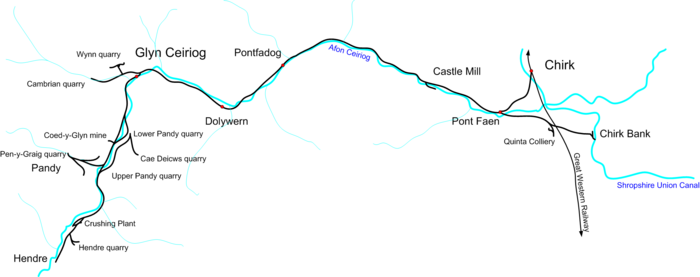Glyn Valley Tramway
| Glyn Valley Tramway | |
|---|---|
| Locale | Wales |
| Dates of operation | 1873 – 1935 |
| Successor line | abandoned |
| Track gauge | 2 ft 4½ in (724 mm) |
| Length | 8¼ miles |
| Headquarters | Chirk |
The Glyn Valley Tramway was a narrow gauge railway that connected Chirk with Glyn Ceiriog in Denbighshire (now Wrexham County Borough), Wales. The gauge of the line was 2 ft 4½ in (724 mm). The total length of the line was 8¼ miles (13.7 km), 6½ miles (10.5 km) of which were worked by passenger trains, the remainder serving a large granite quarry and several minor slate quarries.
Contents
Route
Quarries served
| Name | Product | Start year | End year | Notes |
|---|---|---|---|---|
| Hendre quarry | Granite | 1935 | Internal railway system worked by a Lilleshall Company 0-4-0T locomotive | |
| Upper Pandy quarry | Granite | 1900 | 1908 | |
| Cae-Deicws quarry | Chinastone | 1885 | 1905 | |
| Lower Pandy quarry | Chinastone | 1885 | 1905 | |
| Pen-y-Graig quarry | Silica | 1911 | 1920 | |
| Coed-y-Glyn mine | Granite | |||
| Cambrian quarry | Slate | 1873 | Internal quarry railway was laid to 2 ft (610 mm) gauge and used a W.G. Bagnall 0-4-0ST | |
| Wynne quarry | Slate | 1884 | ||
| Quinta colliery | Coal |
History
The original route
The railway was built to connect the quarries at Glyn Ceriog with the Shropshire Union Canal at Chirk. The Glyn Valley Tramway was incorporated by an Act of Parliament in 1870 which allowed the company to build a tramway from the canal at Chirk Bank to the Cambrian Slate Quarries. This initial line, 6½ miles (10.5 km) was opened in 1873, and was worked by horse and gravity traction. Both passenger and freight traffic was carried from that year.
Rebuilding and extension
In 1885 additional parliamentary powers were obtained to abandon the Quinta Tramway section between Pontfaen and Chirk Bank, replacing it with a new line from Pontfaen to the Great Western Railway's Chirk Station. A two mile extension was also authorized from Glyn to the quarries around Pandy.
Rebuilding of the line was undertaken with steam locomotives borrowed from the Snailbeach District Railways. The new line was opened for freight traffic in 1888 and to passengers in 1891. The new line was operated by steam locomotives purchased from Beyer Peacock in Manchester.
Operation and closure
The two original locomotives, Sir Theodore and Dennis were joined by a third, Glyn in 1892. These tram locomotives worked the line until 1921 when an ex-War Department Light Railways locomotive was purchased. This locomotive was regauged by Beyer Peacock from its original 1 ft 111⁄2 in (597 mm) gauge.
After the First World War costs started to rise significantly, while revenues did not. The railway's financial situation declined steadily during the 1920s. The railway needed to carry approximately 45,000 tons of traffic per year to break even. In 1929 it carried 64,857 tons, but by 1932 this had dropped to 21,400 tons. Increased use of road haulage and a change in the ownership of the remaining quarries was the cause of this downturn in traffic.
In 1932 a bus service was started in the valley, for the first time offering passengers a serious competition to traveling on the tramway. Passenger receipts declined steeply that year, and passenger services were abandoned at the beginning of 1933. Freight traffic continued to decline and the losses to mount on the railway and all services ceased in July 1935 as the company went into voluntary liquidation. The locomotives were all scrapped in 1936.
Preservation
Most of the railway's stock and track were scrapped in the 1930s. However some carriage bodies were sold to local farmers. Two of these bodies survived long enough to be rescued by the Talyllyn Railway where they have been restored to working order and are now used in regular traffic. A quantity of Glyn Valley track also found its way to the Talyllyn.
The Glyn Valley Tramway Group are keeping alive the memory of the line, and own the waiting room at Pontfadog and the Coal Wharf at Glynceiriog, with plans to open a Tramway Heritage Centre.
Locomotives
| Number | Name | Builder | Type | Works Number | Built | Notes |
|---|---|---|---|---|---|---|
| 1 | Dennis | Beyer Peacock | 0-4-2T | 2970 | 1888 | Scrapped 1936 |
| 2 | Sir Theodore | Beyer Peacock | 0-4-2T | 2969 | 1888 | Loaned to the Snailbeach District Railways around 1905. Scrapped 1936 |
| 3 | Glyn | Beyer Peacock | 0-4-2T | 3500 | 1892 | Scrapped 1936 |
| 4 | Baldwin | 4-6-0T | 45211 | 1917 | Acquired by the GVT in 1921; mainly worked freight trains. Scrapped 1936 |
See also
References
- Kidner, R.W. (1947). The Narrow Gauge Railways of Wales, 3rd edition, The Oakwood Press.
- Jones, Richard Bagnold (1958). British Narrow Gauge Railways. A & C Black.
- Boyd, James I.C. (1965). Narrow Gauge Rilways in Mid-Wales. The Oakwood Press.

